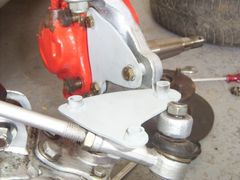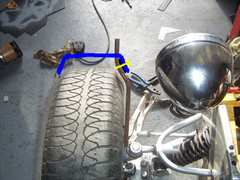
Cycle wings, why do they drop off?
Mark Allanson - 5/9/04 at 08:21 PM
I've got to that stage now, I know that cycle wings have a habit of falling off at the joint of the upright and the flat bar support.
If you made 3 x 13mm erw round uprights instead of 2 19mm, and welded them to a crescent shaped section of flat bar and the cycle wing fastened to the
crescent bar (mounted on the inside), the stresses would be in the wing rather than the supports?
Unless anyone can see a gaping flaw in my thinking, I will make a set like this, I have already made base plates to mount the supports on.


Rescued attachment CycleMount1.jpg
Mark Allanson - 5/9/04 at 08:22 PM
a bit more explanation of how the wings would be mounted to the supports


Rescued attachment CycleMount1a.jpg
Hellfire - 5/9/04 at 09:39 PM
Isn't that what most people do 
Mark Allanson - 5/9/04 at 09:54 PM
I think they normally put braces across the wings, I intend putting one long one along the inner inside length, so the stresses will be in the wing
not the braces or supports
Peteff - 5/9/04 at 11:11 PM
It's usually because the weld causes the metal to turn brittle as it flexes between the stiffer round tube and the flat. 5mm flat should cure it.
I used some angle instead and bolted it to the caliper bolts, an idea from Ray Hudson. Much simpler and strong too.
http://www.locostbuilders.co.uk/upload/wing_mount.jpg
Viper - 5/9/04 at 11:15 PM
Weld if the problem is the weld going brittle, then the awnser is to do what caterham do and braze the assembly
Rob Lane - 6/9/04 at 07:54 AM
The plate is not thick enough. Seriously !!
I have the same design plate with solid 12mm bar uprights and 25x4 flat as wing plates. 3rd design.
After using tube for the uprights (broke easily) , then thick wall tube (broke eventually) , I used the solid bar. No problems with the upright
part.
Now it's the plate that has cracked apart, right across from hole to hole, I've just welded them back up.
This after the trip to Donington.
It's brittle weld stress that causes the problems. This repair is going to be heat treated to relieve the stress
I've considered a second plate welded as a laminated plate to prevent it happening again.
splitrivet - 6/9/04 at 09:19 AM
Made mine from bent conduit and used the caliper bolts for mounting, its so strong you can actually sit on the mudguard without damage.
Sort of looks like your drawing mark but you dont need the outside bend.
Any flexing from the mudguard should be absorbed by the bend in the tube.
I'll take a pic tonight and post it tomorrow.
Cheers,
Bob
[Edited on 6/9/04 by splitrivet]
splitrivet - 8/9/04 at 08:37 AM
Put some pics of my cycle wing mounts in my photo archive if anyones interested they are very very strong and a doddle to make if you have a tube
bender or know a friendly electrician with one.
I know the pics are a bit big, but didnt have photo software on the machine I used to upload em to resize them.
Cheers,
Bob
robbydee - 8/9/04 at 11:52 AM
mark when might you be around for a visit from me and my cat?
Rob TRURO..
JoelP - 8/9/04 at 06:08 PM
quote:
Originally posted by splitrivet
Made mine from bent conduit and used the caliper bolts for mounting...
what do you mean by bent conduit? dimensions and material please! looks like a simple enough thing to make.
looks like a simple enough thing to make. i expect the weld between the two bars
would benefit from a small triangular brace, but it might not be necessary.
i expect the weld between the two bars
would benefit from a small triangular brace, but it might not be necessary.
as an aside, is annealing when you heat metal up and stick it in water? and does this soften it, after work hardening. What is the effect of slowly
cooling the metal? And which of these two processes would most assist a wing bracket fulfill its function?
Mark Allanson - 8/9/04 at 07:02 PM
quote:
Originally posted by robbydee
mark when might you be around for a visit from me and my cat?
Rob TRURO..
Every spare minute is spent building at the moment, but one on the road I will be driving every spare minute - see you then
Rob Lane - 9/9/04 at 08:05 AM
Interesting design.
I would have said it would crack the weld at the 'Y' joint but I see in finished stay that it has a gusset plate for additional load
spread.
Looking at it now the main stress point is the final bend before plate. This is carrying the whole wing load. Weld at this point is vulnerable and
worth keeping an eye on.
Conduit is thicker wall but maleable. Should stand up to it for a long time.
Rob Lane - 9/9/04 at 08:28 AM
Joel,
Heating the part up and allowing to cool very slowly re-aligns the metal structure and takes away the brittleness. BUT it has to be done to a certain
temp for a certain time to be 100%.
However, in our use it's acceptable to heat up to very dull red using a blowtorch and then allow to cool as slow as possible. In insulating
material if poss. We used to use 'vermiculite' but not sure if you can get it.
That way at least some of the stress is relieved.
Welding up and quenching immediately is the worst thing you can do. It creates brittle weld.
That's what we did to weld penetration test pieces to make them break easier.
Electricians conduit, malleable iron welded seam galvanised tube is available in 20 and 25mm suitable for wing stays, it's relatively thick wall
tube compared to some 'bought' wing stays.
splitrivet - 9/9/04 at 09:42 AM
quote:
Originally posted by JoelP
quote:
Originally posted by splitrivet
Made mine from bent conduit and used the caliper bolts for mounting...
what do you mean by bent conduit? dimensions and material please! looks like a simple enough thing to make.
looks like a simple enough thing to make. i expect the weld between the two bars
would benefit from a small triangular brace, but it might not be necessary.
i expect the weld between the two bars
would benefit from a small triangular brace, but it might not be necessary.
By bent conduit I mean conduit which aint straight 
As for dimensions it was made from just standard electrical conduit which I had knocking about in the garage,I didnt work to a design or anything I
just bent it up to suit the task.
If you look at the pic you can see the on finished article I did include a triangular gusset,I tested the first one I made by fitting it then sitting
on it and take it from me Im no lightweight.
As for conduit being strong enough I made a windscreen for my Kawasaki cruiser using it, which is pretty big and thats been in use for 3 years at
speeds of up to 120 with no probs at all.
Cheers,
Bob
Rob Lane - 9/9/04 at 03:56 PM
It's not that it's not strong enough, statically.
It's just that wing stays are in a constant stress when on move, they move with the wheel/hub and are subject to high stress loads.
The wing is accelerating up when suddenly it's subjected to a deceleration then rapid acceleration back again.
This happens constantly when you're on the move and places high loads on wing stays, mountings and materials.
Especially with the lousy pothole roads in this country.
I'm not criticising your wing stays, in fact I like the design. I think the conduit will work out fine.
I'm just pointing out that with a bit of thought you can see the loads they are under.
[Edited on 9/9/04 by Rob Lane]
splitrivet - 10/9/04 at 09:17 AM
Hear what your saying Rob and although I just knocked em up a little thought did go into it as years ago I used to build hang gliders, its just Im
more a seat of your pants not a computer aided design sort of engineer.
As I said in a previous posting conduit was used for the windscreen stays on my bike which has a far higher wind loading which has roughly gotta be a
ton or so and stress level and theyve proved the test of time.
Cheers,
Bob






 looks like a simple enough thing to make.
looks like a simple enough thing to make. i expect the weld between the two bars
would benefit from a small triangular brace, but it might not be necessary.
i expect the weld between the two bars
would benefit from a small triangular brace, but it might not be necessary.